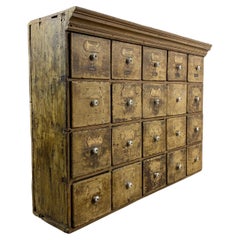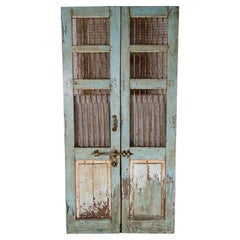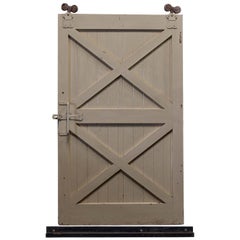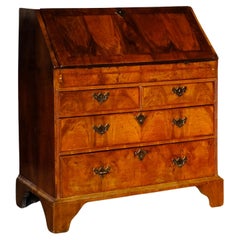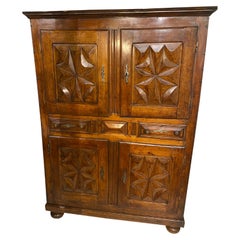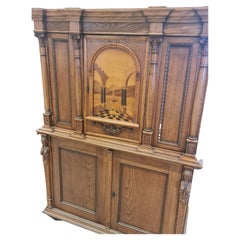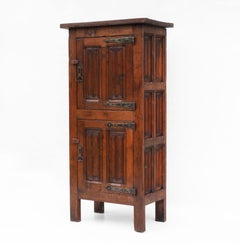21 results for "ironmongery"
to
1
14
6
11
10
4
4
3
2
2
2
2
2
1
1
10
1
1
1
Mid-19th Century Hungarian Multi-Drawered Ironmongery Cabinet
Located in Cirencester, GB
Mid-19th century this lovely bank of drawers was sourced from an ironmongery in Hungary. It has the best patina to the original paint we have found in a while and the porcelain handl...
Category
Antique Mid-19th Century Hungarian Industrial Cabinets
Materials
Pine
Antique Solid Teak French Chateau Sutter Mesh Doors with Original Ironmongery
Located in Llanbrynmair, GB
A very solid, high quality pair of hardwood 19th Century French shutter doors in original paint. A superb looking pair of doors with original ironmongery, including meshed upper section with iron bars.
The doors do not have any glazing so these would have been originally used as shutter type door. Being hardwood, these are suitable for exterior or interior application. Would make a lovely entrance into an ensuite or bathroom or as a decorative feature on a Juliet balcony...
Category
Antique Late 19th Century French French Provincial Doors and Gates
Materials
Teak
19th Century English Oversized Sliding Barn Door
Located in Staffordshire, GB
19th century English oversized sliding pine barn door from a North Yorkshire Barn,
circa 1890.
A great statement door with original cast Iron pulley...
Category
Antique Late 19th Century British Doors and Gates
Materials
Pine
George I Walnut Bureau
Located in Kettering, GB
A George I Walnut Bureau, a beautiful and very original example. The fall-front over two short and two long drawers. Internally a central cupboa...
Category
Antique 18th Century British George I Commodes and Chests of Drawers
Materials
Brass
Vintage Industrial Ebonised Pine Haberdashery Chest Of Workshop Factory Drawers
Located in Sale, GB
- A beautiful bank of industrial ebonised pine workshop drawers of large proportion, circa 1930.
- There are nine drawers in total, all tongue and groove in construction and across t...
Category
Early 20th Century British Commodes and Chests of Drawers
Materials
Pine
17th Century French Provincial Cupboard
Located in Edenbridge, GB
A Stunning French Walnut Provincial cupboard dating from the early 17th Century in the period of Louis XIII.Consists of four carved panelled doors with two drawers and the original ironmongery making this into a truly wonderful and usable early piece of historical antique...
Category
Antique 18th Century French Louis XVI Cabinets
Materials
Walnut
Heavy Pair Of Portico Tables, English, Iron, Statuary, Planter Stand, Victorian
Located in Hele, Devon, GB
This is a pair of portico tables. An English, walnut and cast iron statuary or planter stand, dating to the Victorian period, circa 1850.
Exquisite and substantial ironmongery from ...
Category
Antique Mid-19th Century British Victorian Planters, Cachepots and Jardi...
Materials
Iron
Outsider Art Wall Sculpture: 'It's Time'
By Gerard Cambon
Located in New York, NY
Gérard Cambon was born in 1960 in Toulouse (Fr).
He has a degree in political science and is a self-taught artist.
In the earlier years of his life practiced and experimented with collage and model making. Later, with an interest in old machines and patinas he started collecting old and used objects, tools, and fragments of items whose previous lives remained obvious. When he travels, one of his greatest pleasures is to find materials in antique shops or ironmongeries.
In 1994, he began creating Locomobiles and reliefs and presented them to the public for the first time at “La Jeune Peinture,” a Parisian art fair.
In 1995 , he stayed during 8 months in the hospital for eight months (leukaemia) where he began preparing and creating plans for new Locomobiles and reliefs. As his health improved, he committed himself to his artwork and during the same year met a Parisian gallery owner who decided to organize a solo show for him, Le Galerie Beatrice Soulie in Saint Germain des Pres.
He has shown his work since 1996 in Paris and since 2000 in the United States (New York, Los Angeles, Chicago, Seattle). He is currently being shown by galleries in France, Belgium, Switzerland, Luxembourg , Denmark, and the United States.
He keeps on trying out new materials (fabric, leather, glass, plants, metals,…) that he integrates into his bas-reliefs: traction engines...
Category
2010s Outsider Art Figurative Sculptures
Materials
Metal
Outsider Art Wall Sculpture: 'Electric Factory'
By Gerard Cambon
Located in New York, NY
Gérard Cambon was born in 1960 in Toulouse (Fr).
He has a degree in political science and is a self-taught artist.
In the earlier years of his life practiced and experimented with c...
Category
2010s Outsider Art Figurative Sculptures
Materials
Metal
Outsider Art Wall Sculpture: 'L’usine (IV)'
By Gerard Cambon
Located in New York, NY
Gérard Cambon was born in 1960 in Toulouse (Fr).
He has a degree in political science and is a self-taught artist.
In the earlier years of his life practiced and experimented with collage and model making. Later, with an interest in old machines...
Category
2010s Outsider Art Figurative Sculptures
Materials
Metal
Outsider Art Wall Sculpture: 'TEXACO'
By Gerard Cambon
Located in New York, NY
Gérard Cambon was born in 1960 in Toulouse (Fr).
He has a degree in political science and is a self-taught artist.
In the earlier years of his life practiced and experimented with collage and model making. Later, with an interest in old machines and patinas he started collecting old and used objects, tools, and fragments of items whose previous lives remained obvious. When he travels, one of his greatest pleasures is to find materials in antique shops or ironmongeries.
In 1994, he began creating Locomobiles and reliefs and presented them to the public for the first time at “La Jeune Peinture,” a Parisian art fair.
In 1995 , he stayed during 8 months in the hospital for eight months (leukaemia) where he began preparing and creating plans for new Locomobiles and reliefs. As his health improved, he committed himself to his artwork and during the same year met a Parisian gallery owner who decided to organize a solo show for him, Le Galerie Beatrice Soulie in Saint Germain des Pres.
He has shown his work since 1996 in Paris and since 2000 in the United States (New York, Los Angeles, Chicago, Seattle). He is currently being shown by galleries in France, Belgium, Switzerland, Luxembourg , Denmark, and the United States.
He keeps on trying out new materials (fabric, leather, glass, plants, metals,…) that he integrates into his bas-reliefs: traction engines...
Category
2010s Outsider Art Figurative Sculptures
Materials
Metal
Outsider Art Wall Sculpture: 'The Red House'
By Gerard Cambon
Located in New York, NY
Gérard Cambon was born in 1960 in Toulouse (Fr).
He has a degree in political science and is a self-taught artist.
In the earlier years of his life practiced and experimented with collage and model making. Later, with an interest in old machines and patinas he started collecting old and used objects, tools, and fragments of items whose previous lives remained obvious. When he travels, one of his greatest pleasures is to find materials in antique shops or ironmongeries.
In 1994, he began creating Locomobiles and reliefs and presented them to the public for the first time at “La Jeune Peinture,” a Parisian art fair.
In 1995 , he stayed during 8 months in the hospital for eight months (leukaemia) where he began preparing and creating plans for new Locomobiles and reliefs. As his health improved, he committed himself to his artwork and during the same year met a Parisian gallery owner who decided to organize a solo show for him, Le Galerie Beatrice Soulie in Saint Germain des Pres.
He has shown his work since 1996 in Paris and since 2000 in the United States (New York, Los Angeles, Chicago, Seattle). He is currently being shown by galleries in France, Belgium, Switzerland, Luxembourg , Denmark, and the United States.
He keeps on trying out new materials (fabric, leather, glass, plants, metals,…) that he integrates into his bas-reliefs: traction engines...
Category
2010s Outsider Art Figurative Sculptures
Materials
Glass, Mixed Media
Outsider Art Wall Sculpture: 'Numbers'
By Gerard Cambon
Located in New York, NY
Gérard Cambon was born in 1960 in Toulouse (Fr).
He has a degree in political science and is a self-taught artist.
In the earlier years of his life practiced and experimented with collage and model making. Later, with an interest in old machines and patinas he started collecting old and used objects, tools, and fragments of items whose previous lives remained obvious. When he travels, one of his greatest pleasures is to find materials in antique shops or ironmongeries.
In 1994, he began creating Locomobiles and reliefs and presented them to the public for the first time at “La Jeune Peinture,” a Parisian art fair.
In 1995 , he stayed during 8 months in the hospital for eight months (leukaemia) where he began preparing and creating plans for new Locomobiles and reliefs. As his health improved, he committed himself to his artwork and during the same year met a Parisian gallery owner who decided to organize a solo show for him, Le Galerie Beatrice Soulie in Saint Germain des Pres.
He has shown his work since 1996 in Paris and since 2000 in the United States (New York, Los Angeles, Chicago, Seattle). He is currently being shown by galleries in France, Belgium, Switzerland, Luxembourg , Denmark, and the United States.
He keeps on trying out new materials (fabric, leather, glass, plants, metals,…) that he integrates into his bas-reliefs: traction engines...
Category
2010s Outsider Art Figurative Sculptures
Materials
Metal
Outsider wall sculpture: 'Big Brother'
By Gerard Cambon
Located in New York, NY
Gérard Cambon was born in 1960 in Toulouse (Fr).
He has a degree in political science and is a self-taught artist.
In the earlier years of his life practiced and experimented with c...
Category
2010s Outsider Art Figurative Sculptures
Materials
Mixed Media
Outsider Art Wall Sculpture: 'Les fleurs du mal (II)'
By Gerard Cambon
Located in New York, NY
Gérard Cambon was born in 1960 in Toulouse (Fr).
He has a degree in political science and is a self-taught artist.
In the earlier years of his life practiced and experimented with collage and model making. Later, with an interest in old machines and patinas he started collecting old and used objects, tools, and fragments of items whose previous lives remained obvious. When he travels, one of his greatest pleasures is to find materials in antique shops or ironmongeries.
In 1994, he began creating Locomobiles and reliefs and presented them to the public for the first time at “La Jeune Peinture,” a Parisian art fair.
In 1995 , he stayed during 8 months in the hospital for eight months (leukaemia) where he began preparing and creating plans for new Locomobiles and reliefs. As his health improved, he committed himself to his artwork and during the same year met a Parisian gallery owner who decided to organize a solo show for him, Le Galerie Beatrice Soulie in Saint Germain des Pres.
He has shown his work since 1996 in Paris and since 2000 in the United States (New York, Los Angeles, Chicago, Seattle). He is currently being shown by galleries in France, Belgium, Switzerland, Luxembourg , Denmark, and the United States.
He keeps on trying out new materials (fabric, leather, glass, plants, metals,…) that he integrates into his bas-reliefs: traction engines...
Category
2010s Outsider Art Figurative Sculptures
Materials
Metal
Outsider Art Wall Sculpture: 'Adding Machine'
By Gerard Cambon
Located in New York, NY
Gérard Cambon was born in 1960 in Toulouse (Fr).
He has a degree in political science and is a self-taught artist.
In the earlier years of his life practiced and experimented with c...
Category
2010s Outsider Art Figurative Sculptures
Materials
Mixed Media
Outsider wall sculpture: 'The Red Factory'
By Gerard Cambon
Located in New York, NY
Gérard Cambon was born in 1960 in Toulouse (Fr).
He has a degree in political science and is a self-taught artist.
In the earlier years of his life practiced and experimented with c...
Category
2010s Outsider Art Figurative Sculptures
Materials
Mixed Media
Huge Illuminated Advertising Clock by Gensign
Located in London, GB
A huge Illuminated Advertising clock by Gensign
We are proud to offer a rare and remarkable double-sided ironmongers advertising Gensign Clock. The ...
Category
Vintage 1920s British Victorian Grandfather Clocks and Longcase Clocks
Materials
Metal, Sheet Metal
Low Table in Cast Iron with Custom Size and Finish Variations Available
By Charlotte Kingsnorth
Located in New York, NY
Capturing the visual functionality of iron work from the industrial revolution period (where bolts are used to physically hold iron parts together, but also as a form of industrial d...
Category
21st Century and Contemporary American Coffee and Cocktail Tables
Materials
Iron, Metal
Fog & Mørup Set of Three Little Chandelier
By Fog & Mørup
Located in bari, IT
Set of three little suspensions in aluminum green colored model "semi" by Fog & Mørup.
Ansgar Fog and E Mørup met in 1902 at the firm of Marinus Kock in Aarhus, Denmark. They rapidly became close friends and began to develop the idea of going into business together. On 22 February 1904 they answered an advertisement in the newspaper Jyllandsposten calling for ‘an energetic man to take over a well-established ironmongery and consignment warehouse’. Fog Morup...
Category
Vintage 1960s Mid-Century Modern Chandeliers and Pendants
Materials
Aluminum
Chandelier Art deco, Designer: Edgard Brandt, 1920, France, material: iron
By Edgar Brandt
Located in Ciudad Autónoma Buenos Aires, C
Amaizing hanging lamp Designer: Edgard Brandt
Material: iron
Style: Art Deco
Country: France
To take care of your property and the lives of our customers, the new wiring has been done.
We have specialized in the sale of Art Deco and Art Nouveau and Vintage styles since 1982. If you have any questions we are at your disposal.
Pushing the button that reads 'View All From Seller'. And you can see more objects to the style for sale.
Why are there so many antiques in Argentina?
In the 1880 – 1940 there was a grate wave of immigration encouraged by the periods of war that were taking place.
1st World War took place between 1914 and 1918
2nd World War took place between 1939 and 1945
The immigrants options were New York or Buenos Aires. Tickets were cheap and in Buenos Aires they were welcomed with open arms, as it was a country where everything was still to be done.
Argentina was the country of new opportunities, labour was needed and religious freedom was assured, in many cases the of the family travel first until they were settled and then the rest of the family members join them.
In the immigrant museum “Ellis Island Immigrant Building” in New York you can se the promotional posters of the boats that would take them to a new life.
Between the years 1895 and 1896, Argentina had the highest DGP (gross domestic product) per capita in the world according to the Maddison Historical Statistics index, this situation arose due to the large amount of food being exported to European countries, which were at war.
The Argentinean ships left the port of Buenos Aires with food, but they returned with furniture, clothes and construction elements, (it´s common to see this the old buildings of the historic neighbourhood of San Telmo, the beams with the inscription “Made in England)”, as well as many markets that were built in Buenos Aires, such us the San Telmo Market, whose structure was brought by ship and afterwards assembled in 900 Defensa Street.
With the great influence of European immigrants living in the country, the children of the upper classes travelled to study in France, resulting in the inauguration of “La Maison Argentinienne”, on 27th of June 1928, in the international city of Paris, which hosted many Argentinians that were studying in Frace.
It´s the fourth house to be built after France, Canada and Belgium, being the first Spanish-speaking one. Still in place today (17 Bd Jourdan, 75014, Paris, France). Many of the children of these wealthy families who attended international art exhibitions, museums and art courses abroad, took a keen interest in the European style. This is why Buenos Aires was at the time referred as “The Paris of South America”.
Between the years 1890 and 1920 more than a hundred Palaces were built on Alvear Avenue the most exclusive avenue in Buenos Aires. Today some of these palaces have been transformed into museums, hotels and embassies.
In the year 1936, the Kavanagh building was inaugurated, it was the tallest reinforced concrete building in South America.
During 1994 the American Society of Civil Engineers distinguished it as an “international engineering milestone”, and it´s now considered a World Heritage of Modern Architecture.
At the time was common to hire foreign architects such as Le Corbusier, who visited Buenos Aires/Argentina in 1929 and in 1948 he drew up the blueprints for a house built in La Plata City (which was declared a World Heritage Site).
In 1947, the Hungarian architect Marcelo Breuer designed “Parador Ariston” in the seaside city of Mar del Plata. After an Argentinean student at Harvard University convinced him to come to Argentina. He worked on an urban development project in the Casa Amarilla, area of La Boca.
The Ukrainian architect, Vladimiro Acosta, arrives in Argentina in 1928 and worked as an architect until que moved to Brazil.
Antonio Bonet, a Spanish architect who worked with Le Corbusier in Paris, arrives in Argentina in 1937, where he carried out several architectural works and in 1938 designs the well-known BFK chair.
Andres Kálnay, of Hungarian origin, made around 120 architectural masterpieces, among which the former Munich brewery stands out, he even made the furniture’s design.
The German architect, Walter Gropius, director of the Bauhaus, lived in Argentina, where he wrote articles for “Sur” magazine and founded in Buenos Aires, an architectural firm with Franz Möller, who was also an architect, where he built two houses.
At the same time several famous designers decided to immigrate to Argentina, among them we can find the well-known French designer, Jean-Michel Frank, who arrived in the country in 1940 and also worked for the Rockefeller family.
Special pieces were made, which were sold exclusively in the country, such as the well-known German company “WMF”, who sold their products by catalogue, which were chosen by the ladies of high society in the list of wedding gifts, as well as the pieces designed by Christofle.
The Swiss sculptor Alberto Giacometti, made special pieces for Argentinean mansions.
In 1904 the first Jansen branch outside Paris was established in Buenos Aires, as the Argentinean clientele demanded a large amount of furniture, from the end of the 19th century to the mid-20th century.
In 1970, the brand Rigolleau Argentina made pieces authorised by Lalique.
The brands Maple and Thompson also set up shop in the country.
The French plastic artist, Marcel Duchamp moved to Argentina in 1918-1919.
Glass signed Gallé, Charder, Leverre, Schneider, Muller and other French firms. They were bought in flower shops and were given to ladies with beautiful floral arrangements.
Some furniture manufacturers travelled to international fairs and bough the patterns to produce the furniture in Argentina, such as the furniture firm Englander and Bonta, who bought the patterns ins Italy.
It is worth mentioning that in Argentina we have the largest community of Italians outside of Italy, as it is estimated that 70 percent of the inhabitants have at least one Italian descendant, followed by Spanish immigrants.
The most Important furniture stores in Argentina:
Comte is founded in 1934 (under the direct management of Jean Michel Frank in 1940).
Nordiska (Swedish company established in 1934).
Churba in 1960, a company that brought foreign designers to present their furniture in the country:
Denmark: (Arne Jacobsen, Finn Juhl, Bender Madsen, Ejner Larsen, Poul Kjaerholm, Hans Wegner)
Sweden: (Hans Agne Jakobsson, Gustavsberg)
United States: (Herman Miller)
Finland: (Lisa Johansson, Folke Arstrom, Tapio Wirkkala, Alvar Aalto, Timo Sarpaneva)
Swedish Factory: (Orrefors)
Italy: (Littala, Vico Magistretti, Emma Gismondi, Gae Aulenti, Angelo Mangiarotti, Elio Martinelli, Gianna Celada, Angelo Mangiarotti, Mario Bellini, Carlo Scarpa)
Finland: (Olivia Toikka)
Plata Lappas (Lappas Silver): a goldsmith shop founded in 1887 in Argentina by Alcibiades Lappas of Greek origin.
In 2019, in Argentina took place “the Art Deco world congress”, in which we participated as hosts invited by Geo Darder, founder of the Copperbridge – Foundation, in which prominent people from all over the world attended to learn about Art Deco in Argentina.
Argentina currently has more than 100 Art Deco buildings and another 90 Art Nouveau buildings throughout the city of Buenos Aires.
Argentina is a country that has not been involved in many wars, which is why it has been a refuge for works of art and antiques from different periods of time, unlike European countries. That is way many collectors, museums and antique dealers from all over the world visit it, you should not miss the opportunity to visit this great country.
Laura Guevara Kjuder, architect.
If you want to live in the golden years, this is the lighting that your project needs.
We have specialized in the sale of Art Deco and Art Nouveau and Vintage styles since 1982.If you have any questions we are at your disposal.
If you are looking for sconces to match your ceiling lighting, we have what you need.
Pushing the button that reads 'View All From Seller'. And you can see more objects to the style for sale.
Edgar Brandt
He was born in Paris on December 24, 1880. His family moved to Orleans when Brandt was 4 years old. At age 18, he graduated the Brevet Technicien Superieur and did two years military service with the 153rd infantry in Nancy. Brandt was awarded a gold medal 1st class, at the Salon des Artistes Francais, and became a member of the vetting team of the organization. In 1904, he was ordered to go to Toul near Nancy for military service. There it became apparent to him that the French Infantry had no light versatile weapon with a long target-range. At the end of the year he returned to Paris with the order to design and make a 60mm mortar and the required ammunition. Trained in the Ecole Professionnelle de Vierzon, he set up an ironmongery in Paris. There he created gates, balustrades, floor lamps and chandeliers in bronze, hammered wrought iron and steel for grand houses and ocean liners. His style was typical for the period with cone-fires, branches, fruits, and even birds and human faces. After the WWI, he created the Tomb of the Unknown Soldier under the Paris Arc de Triomphe. He participated in the famous Exposition Internationale des Arts Decoratifs de 1925 in Paris, making the monumental gate...
Category
Vintage 1920s French Art Deco Chandeliers and Pendants
Materials
Iron
Related Items
Antique Cabinet, 19th Century
Located in Kerepes, HU
We present to you this special 2-door guessboard in classic style.
Category
Antique Late 19th Century European Neoclassical Cabinets
Materials
Wood
Reclaimed Pair 19th Century 2 Panel English Pine Cupboard Doors
Located in Mckinney, TX
A pair of reclaimed 2-panel cupboard doors having beveled trim details. Enclose a built-in cabinet with this charming pair of doors to add warmth and infuse your home with a touch of...
Category
Antique 19th Century English Doors and Gates
Materials
Pine
French Ebonised Distressed Pine Chest of Drawers/Dresser c.1930's
Located in London, GB
This French ebonised distressed Pine chest of drawers/dresser, is a stunning piece of Vintage furniture from the 1930s. This piece was sourced in Le Harve France, the ebonised finish...
Category
Vintage 1930s French Country Commodes and Chests of Drawers
Materials
Brass
19th Century French Painted Barn Door
Located in Los Angeles, CA
19th century French painted barn door with beautiful worn distressed finish. Cream, blue and remnants of ochre colored paint are seen throughout this fabulous door. It would make a great room divider...
Category
Antique 19th Century French Country Doors and Gates
Materials
Wood
17th Century Italian Walnut Cabinet
Located in Montreal, QC
17th century Italian walnut buffet-cabinet, probably Tuscan c.1680
Category
Antique 1680s Italian Baroque Cabinets
Materials
Walnut
Pine Chest of Three Drawers
Located in Baltimore, MD
This is a splendid three drawer chest with an interesting configuration of drawers. The top drawer is shallow and the middle one is the deepest. The bottom drawer is just in-betwee...
Category
Antique Late 19th Century Hungarian Country Commodes and Chests of Drawers
Materials
Pine
Antique George I Quality Walnut Chest of Drawers
Located in Suffolk, GB
Antique George I quality walnut chest of drawers having a quality walnut rectangular top with a moulded edge above two short and three long walnut crossbanded drawers with attractive...
Category
Antique 1740s English George I Commodes and Chests of Drawers
Materials
Walnut
Arne Jacobsen Door Handles in Solid Brass
By Arne Jacobsen
Located in Copenhagen, DK
ARNE JACOBSEN - SCANDINAVIAN MODERN
Beautiful and sculptural door handles (9.7cm) in solid brass by Arne Jacobsen.
Designed for SAS Royal...
Category
Mid-20th Century European Mid-Century Modern Doors and Gates
Materials
Brass
Antique Double Glass Door with Frame, Early 1900s Italy
Located in Cuneo, Italy (CN)
Antique double internal door with frame, with glass and molure doors, complete with original frame and overdoor with lacquered wood panel, early 1900s, already restored and in excell...
Category
Early 20th Century Italian Doors and Gates
Materials
Wood
Pair 19th Century English Pine Paneled Cupboard Doors
Located in Mckinney, TX
A pair of reclaimed paneled cupboard doors having beveled trim details. Incorporate these timeless pieces of craftsmanship into your modern home to ad...
Category
Antique 19th Century English Doors and Gates
Materials
Pine
Early 19th Century Oak Door from France
Located in Dallas, TX
This oak door origins from France, circa 1820.
Category
Antique Early 19th Century French Doors and Gates
Materials
Oak
19th Century French Provincial Wardrobe Door
Located in Mckinney, TX
19th-century French provincial wardrobe door with carved upper panel and grooved beveled trim detailing. Install in a new home to enclose a pantry or linen cupboard to instantly add ...
Category
Antique 19th Century French Doors and Gates
Materials
Oak
Previously Available Items
Art and Crafts Oak Cabinet c1900
Located in Trensacq, FR
Beautiful English Art and Crafts oak cabinet c1900
Two-door panelled oak cupboard wonderfully carved in Tudor revival linenfold design and furnished with...
Category
Antique Early 1900s British Arts and Crafts Cabinets
Materials
Iron
Art & Crafts Oak Cupboard, c1900
Located in Trensacq, FR
Beautiful English Arts & Crafts cupboard c1900.
A single-piece, four-door, two cupboard, linen press with wonderfully carved oak panels in Tudor revival linenfold design and finis...
Category
Early 20th Century British Arts and Crafts Linen Presses
Materials
Steel
French 19th Century Balcony Console
Located in Tetbury, Gloucestershire
Striking 19th century balcony console. Originally from France, this console would have surrounded a window, overlooking the landscape. This console is ...
Category
Antique 19th Century French Console Tables
Materials
Iron
1930s French Tambour Fronted Oak Notaires Cabinet
Located in Hook, Hampshire
1930s vintage French tambour fronted solid Oak Notaires cabinet. Sourced in the South East of France this is a lovely original Notaires cabinet with ori...
Category
Vintage 1920s French Other Cabinets
Materials
Wood
French, 19th Century, Balcony Console
Located in Gloucestershire, GB
Striking 19th century iron and marble balcony console.
Originally from France, this console would have surrounded a window, overlooking the landscape....
Category
Antique 19th Century French French Provincial Console Tables
Materials
Iron
1930s French Tambour Fronted Oak Notaires Cabinet
Located in Hook, Hampshire
1930s French tambour fronted oak Notaires cabinet
1930s vintage French tambour fronted solid oak Notaires cabinet. Sourced in the South East of France ...
Category
Vintage 1930s French Shelves
Materials
Oak
Hulsta Rosewood Lounge Wall
Located in Alton, GB
A stunning piece of modular cabinetry that carries an imposition of almost architectural proportions.
Created by the renowned German furniture manufacturer Hulsta, this bank of wall units spans 5 meteres made up of 5 individual 1 metre units each of a 2.5 meter height.
This lounge wall is faced off in two colorations of rosewood and dates to the late 1960's, early 1970's. Typical of Hulsta furniture, the units are extremely well made and when linked together create the impression of a complete wall casing with an assortment of display, library and doored sections.
There is a mixture of closed face, open and glazed units...
Category
Late 20th Century Cabinets
Materials
Glass, Rosewood
Mid-Century Modern Rope and Teak Table Lamp by Fog & Mørup
By Fog & Mørup
Located in Buffalo, NY
Ansgar Fog (1880-1930) and Erik Mørup (1879-1972) founded the company Fog & Mørup in 1904, having acquired an “ironmongery and consignment warehouse” in Fiskergyde, in Aarhus, with a large inventory of among other things paraffin lamps...
Category
Mid-20th Century Danish Scandinavian Modern Table Lamps
Materials
Hemp, Teak
Outsider Art Wall Sculpture: 'Haffa'
By Gerard Cambon
Located in New York, NY
Gérard Cambon was born in 1960 in Toulouse (Fr).
He has a degree in political science and is a self-taught artist.
In the earlier years of his life practiced and experimented with collage and model making. Later, with an interest in old machines...
Category
2010s Outsider Art Figurative Sculptures
Materials
Metal
Outsider Art Wall Sculpture: 'The Lodge'
By Gerard Cambon
Located in New York, NY
Gérard Cambon was born in 1960 in Toulouse (Fr).
He has a degree in political science and is a self-taught artist.
In the earlier years of his life practiced and experimented with collage and model making. Later, with an interest in old machines and patinas he started collecting old and used objects, tools, and fragments of items whose previous lives remained obvious. When he travels, one of his greatest pleasures is to find materials in antique shops or ironmongeries.
In 1994, he began creating Locomobiles and reliefs and presented them to the public for the first time at “La Jeune Peinture,” a Parisian art fair.
In 1995 , he stayed during 8 months in the hospital for eight months (leukaemia) where he began preparing and creating plans for new Locomobiles and reliefs. As his health improved, he committed himself to his artwork and during the same year met a Parisian gallery owner who decided to organize a solo show for him, Le Galerie Beatrice Soulie in Saint Germain des Pres.
He has shown his work since 1996 in Paris and since 2000 in the United States (New York, Los Angeles, Chicago, Seattle). He is currently being shown by galleries in France, Belgium, Switzerland, Luxembourg , Denmark, and the United States.
He keeps on trying out new materials (fabric, leather, glass, plants, metals,…) that he integrates into his bas-reliefs: traction engines...
Category
2010s Outsider Art Figurative Sculptures
Materials
Metal
Pair of Large Important Cabinets by Martin Nyrop & Rud. Rasmussen for City Hall
By Martin Nyrop, Rud Rasmussen
Located in London, GB
A pair of free-standing cabinets designed by architect Martin Nyrop and made by Rudolph Rasmussen circa 1900.
The cupboards until recently were part of Copenhagen City Hall, the Dan...
Category
Antique Early 19th Century Danish Arts and Crafts Cabinets
Materials
Iron
H 82.29 in W 36.62 in D 18.31 in
C R Mackintosh, Arts & Crafts Glasgow School Writing Cabinet with Foliate Hinges
By Charles Rennie Mackintosh
Located in London, GB
Charles Rennie Mackintosh (1868-1928), a cypress wood and brass writing cabinet, formerly green stained, with large stylized fret work foliate hinges, heart escutcheons and conforming handles to the central drawer. A fold down writing area with drawers, pigeon holes and a shelf behind, the lower section with two shelves retaining it's original brass rail for a curtain.
This Writing cabinet is the same style of furniture that Mackintosh designed for John Henderson. For similar see Kaplan, Wendy (editor) 'Charles Rennie Mackintosh', pl. 159. opposite p. 233. The original furniture Mackintosh designed for Guthrie and Wells was made from cypress wood and stained green and of simple construction. This unique style and construction are the same. Behind the hinges and handles the original green stain is still quite vibrant. The keyhole escutcheons are identical to the linen press with candle sconces that Mackintosh designed for John Henderson, one of the earliest known surviving pieces he designed. The back treatment of this present lot is the same and has just three wide boards which run from the top right to the floor. The side treatment is also from the top straight to the ground quite typical of Mackintosh. For this see Kaplan, Wendy (editor) 'Charles Rennie Mackintosh', p. 232, fig 160 and Billcliffe, Roger 'Charles Rennie Mackintosh: The Complete Furniture, Furniture Drawings, and Interior Designs', p.34, fig. 1895.6. The metalwork is identical on some pieces and very similar on others, see the Billcliffe work above, p. 33, fig. 1895.2 and 1895.3 for washstand and dressing table handles...
Category
Antique Late 19th Century Scottish Arts and Crafts Desks and Writing Tables
Materials
Brass
H 62.5 in W 38 in D 18 in
